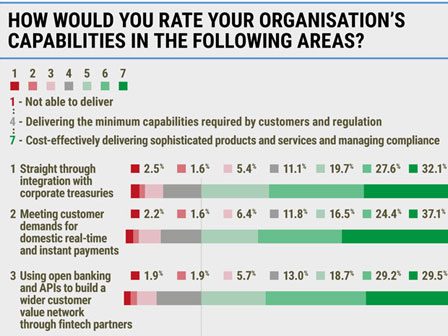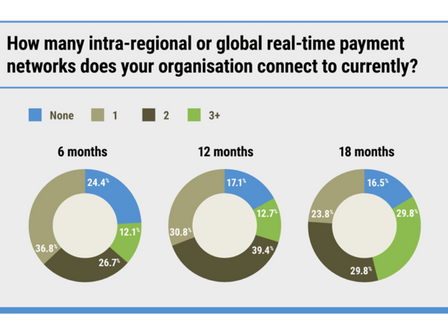A Evolving Landscape
Technology is the most powerful change agent in a rapidly evolving digital world. One of the many industries undergoing technology-based disruptive change is the banking industry, and in particular, the payments segment. According to a recent survey of 150 global banks from Accenture, 86% agree that technology is increasing the level of integration between financial services and customers’ lives, so the expectation for a frictionless payments experience is a key component for any new strategic approach going forward.
The COVID-19 pandemic has expedited the adoption of digital transactions, in particular real-time 24×7 account-to-account payments. Volante’s 2021 US mid-tier bank survey reveals that real-time payments connections are expected to triple within the year, with a quarter of the 160 institutions surveyed viewing increased efficiency and productivity in their current payments operations as a top priority.
However, as next-gen payments grow, so does fraud. The ISO 20022 standard will help mitigate this by capturing more details in the payment messages, thereby increasing interoperability across domestic and cross-border payment systems. However, not all legacy systems can effectively handle ISO 20022 messages, creating a roadblock for many institutions in their modernization roadmaps.
The emerging payments landscape is complex, but the drivers for modernization can be grouped into three broad categories: customer demand, regulatory innovation, and digital scalability.
“The Big Three” In Brief
Customer Demand: Banks are facing increasing customer demand to provide real-time payments for both domestic and cross-border payments. Innovations such as SWIFT gpi and Ripple settle cross-border transactions in near real-time at no extra cost. Cross-border payment rails such as Visa B2B give banks more options to route their payments based upon the cost and benefits provided. Customers are also asking for more data with their payments, 24×7 coverage, and straight-through API based connectivity to their providers.
Regulatory Innovation: Banking is a highly-regulated industry. Some regulations come from central banks, while other common standards originate from organizations such as SWIFT. While the term “innovation” is not often associated with regulatory compliance, initiatives like PSD2 in Europe and Open Banking are designed to spur innovation, and are changing the way consumers and businesses transact, through third-party PSPs and not just through banks. On the messaging front, SWIFT is migrating to the ISO 20022 messaging format by 2024-25 at which point all banks must comply to continue sending cross border payments through SWIFT—another opportunity for innovative applications of the ISO 20022 standard.
Digital Scalability: In order to handle huge transaction volumes and to support next-gen payments, bank systems need scalability—not just in the narrow technical sense, but in the broader sense of enabling banks to scale as digital-native organizations. This means being able to support transactions 24×7, keeping downtime to a minimum, and smoothly handling volume spikes. It also means being able to support an increasing diversity of payment channels and clearing and settlement mechanisms (crypto and CBDCs come to mind), as well as ecosystem partnerships with fintechs, API banking, and other drivers of scale.
Responding To The Challenge
In the last few years, in direct response to the “Big Three” drivers, the payment industry has been disrupted by challengers and fintechs who cater to customer needs with the lowest cost possible, providing compelling customer experiences based on novel technology.
To keep pace, banks and financial institutions need to look at strategic system upgrades through best-of-breed solutions to run efficient utilities leveraging the power of cloud provisioning. A case in point is Goldman Sachs, who launched a brand-new transaction banking offering in 2020, Goldman Sachs TxB, on a legacy-free cloud platform.
What characteristics should a modern payment platform have, in order to enable banks to rise to the challenge of the “Big Three” drivers of payments modernization? At Volante, we believe strongly that modern payment platforms have the following characteristics:
- The ability to run multiple rails on the same core infrastructure, providing different options for routing the transaction through the fastest and lowest cost possible
- A broad and deep roadmap that enables innovation through the incorporation of future payment rails, from updated domestic ACH/RTGS systems to new real-time and cross-border networks
- Cloud-native to guarantee digital scalability, upgradeability, and 24×7 uptime
- Microservices based, giving banks the flexibility to buy and use only the services they and their customers need
- Open Banking, PSD2 and API-ready, creating a platform for banks to move beyond compliance to competitive differentiation, and a strong partner ecosystem
- ISO 20022-fluent, helping banks accommodate transformation without causing any major disruptions to their existing legacy systems, while laying the groundwork for future leverage of the ISO 20022’s extended data capabilities
- The ability to facilitate migration to a full Payments as a Service (PaaS) model, reducing short and long-term costs as end-to-send services can be outsourced to the PaaS provider
With these elements in place, banks gain the freedom to think beyond the limitations of legacy technologies, enabling them to respond faster to change and to deliver the benefits of modern frictionless digital payments to their customers. Banks will evolve from targets for competitive disruption into the innovation leaders of tomorrow, an improvement which will reflected not just in their balance sheets, but also in the way customers experience their services.
To learn more about Volante’s payments modernization solutions, visit our page on the VolPay ecosystem. To learn how Volante’s Payments as a Service can fast-track a bank’s modernization roadmap, visit our PaaS solutions portal.







